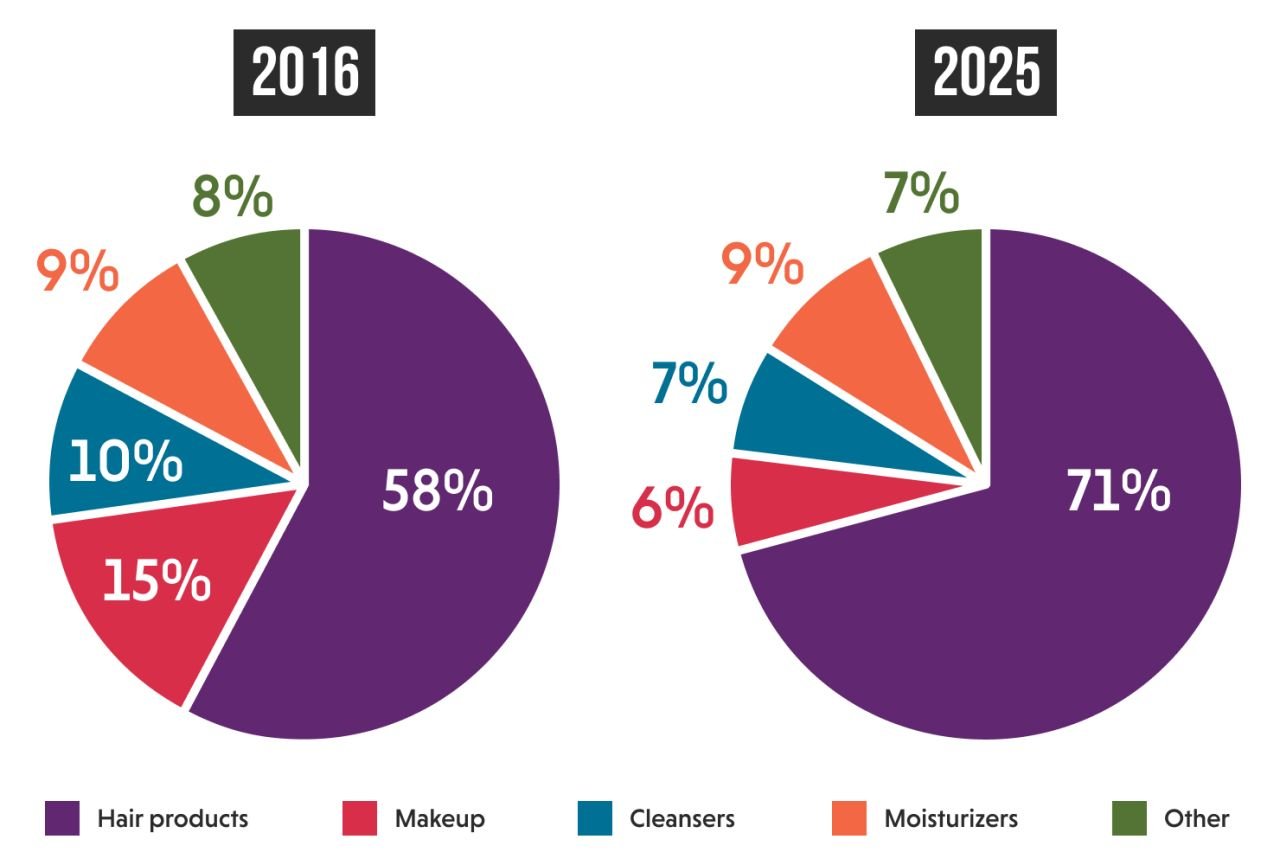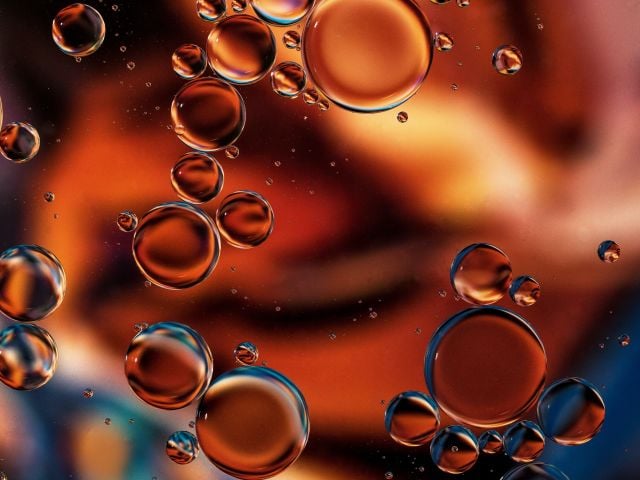
Overview
- Beauty justice research shows the use of certain personal care products may increase Black women’s exposure to hazardous chemicals.
- Products like hair relaxers and dyes are linked to elevated risks of several diseases, including breast and uterine cancer, especially for Black women.
- Since EWG’s 2016 report on products marketed to Black women, policy and product formulation changes have spurred some safety improvements – but there are still fewer low hazard products marketed to Black women compared to the market as a whole.
Out of 4,011 personal care products marketed to Black women, only 21 percent rate as low hazard in EWG’s Skin Deep® cosmetics database according to this newly updated EWG analysis co-authored with BLK + GRN Founder Kristian Edwards, DrPH.
The analysis shows that disparities in personal care product safety persist almost a decade after EWG released its first report on products marketed to Black women in 2016. And the hazards are found in several categories of popular items like hair care products, some moisturizers, and certain types of makeup.
EWG and BLK + GRN’s updated analysis underscores the scope of the problem, demonstrating that Black women may have fewer low hazard product options.
While policy and product formulation changes since release of the 2016 report have helped improve personal care product safety, disparities still exist between products marketed to Black women and products without demographic marketing.
Figure 1: Skin Deep score range

In our analysis of 4,011 products marketed to Black women, about one in 20 ranked highly hazardous based on the scoring methodology for Skin Deep, a free online resource for finding less-hazardous personal care products.
Skin Deep compares product ingredients to more than 60 toxicity and regulatory databases and scientific studies, and rates the products from 1 (lowest hazard) to 10 (highest hazard). Including the products analyzed for this report, Skin Deep now rates more than 121,000 products (see Methodology section below for more information on scoring). These product ratings are based on EWG’s assessment of ingredient hazards and overall product formulations, detailed later in the report. Additionally, product ratings can also inform assessment by product categories (see Product category breakdown below).
The analysis also found that:
- Fewer products marketed to Black women scored low hazard compared to products with no demographic marketing.
- Of the nine ingredients of concern identified in our 2016 report, eight are less prevalent among the products evaluated in the 2025 report. This includes steep declines in paraben use. But use of undisclosed fragrance ingredients increased.
- Hazard scores improved for only four of the 12 product categories evaluated in both the 2016 and 2025 reports. The other eight categories showed a shift towards moderate or high hazard products.
- Hair relaxers remain a hazardous product category, though different hazards may be posed by professional hair relaxing treatments not covered in this report. Over a quarter of the hair relaxer products evaluated had at least one formaldehyde-releasing preservative, and 78 percent of the evaluated hair relaxers contained the caustic ingredients sodium hydroxide, calcium hydroxide, or both.
Health disparities and personal care products
Health disparities in the United States are well-documented, and environmental justice research has identified differences in chemical exposures as a source of these disparities. Yet personal care products only recently began to be considered as a factor in health disparities research.
A landmark 2017 paper by university researchers framed personal care product exposure disparities and the related health issues faced by women of color as “the environmental injustice of beauty.” Ongoing beauty justice research emphasizes how racialized beauty standards contribute to these disparities.
Our analysis of the products marketed to Black women in Skin Deep further supports the conclusions of existing beauty justice research, highlighting ongoing exposure disparities that disproportionately affect Black women.
Beauty justice research reports differences in chemical exposures and health outcomes attributed to personal care product use. Exposure studies have shown higher urinary phthalate concentrations for pregnant Black and Hispanic women, elevated phthalate and paraben levels for Black and Mexican women, and that these exposure disparities may be further exacerbated by socioeconomic status.
Health outcome studies have reported associations between the use of hair dye and hair straighteners and risk of developing breast cancer was more pronounced for Black women than for white women. Data from the Black Women’s Health Study showed an increased risk of uterine cancer for postmenopausal women who had frequently used hair relaxers, though whether these were professional or at home products was not reported.
In addition to exposure and health studies, a recent Harvard study using Skin Deep scores found that stores in Boston neighborhoods with a higher percentage of residents of color were more likely to sell products that score as higher hazard compared to Boston neighborhoods with a higher percentage of white residents. The authors concluded that these geographic disparities in the availability of safer personal care products may contribute to exposure disparities for people of color, mirroring other examples of geographic systemic racism such as redlining and discriminatory zoning.
Furthermore, due to differences in marketing, use patterns, and safety profiles, certain product categories may be more likely to drive exposure and even health disparities.
In Skin Deep, some of the highest hazard product categories, regardless of whether they are marketed specifically to Black women, are hair care and styling products, skin fading and lightening creams, and fragranced lotions and creams. These are some of the same product categories identified as being potential sources of health disparities for Black women.
This report updates EWG’s 2016 report and analyzes product ingredients and scores to 1) determine whether Skin Deep data can be used to examine the disparities highlighted in the literature and 2) identify opportunities for the creation and use of safer products.
Products analyzed for this report
From December 2023 through August 2024, EWG conducted in-store data collection and online research and worked with BLK + GRN to identify 4,011 products marketed to Black women for inclusion in this report (see Methodology section below for further detail).
Overall the product breakdown by category is similar to the 2016 analysis, with two differences: the 2025 report includes more hair products, but fewer makeup products and cleansers (see Figure 5 in the Methodology section).
Figure 2: Skin Deep hazard scores for products marketed to Black women in the 2016 and 2025 reports

Using the Skin Deep database, we evaluated the hazard scores for each product:
- Similar to 2016, fewer than one fourth of products score 1 or 2 – green for low potential hazard – in the 2025 report.
- The percent of products scoring 3 to 6 – yellow for moderate potential hazard – increased from 70 percent in 2016 to 74 percent in 2025.
- The percent of products scoring 7 to 10 – red for high potential hazard – decreased from 8 percent in 2016 to 4.9 percent in 2025
These score shifts suggest some formulation improvement in products marketed to Black women between 2016 and 2025. However, current Skin Deep data show that disparities persist in the overall safety of these products when compared to personal care products without specific demographic marketing.
Product hazard scores
There seems to have been a shift from high hazard to moderate hazard formulations between 2016 and 2025, yet current Skin Deep data show that a lower percentage of products marketed to Black women score as low hazard compared to products without demographic marketing.
A total of 21.1 percent of products marketed to Black women scored green or low hazard in Skin Deep compared to 27.4 percent of products without demographic marketing – a difference of six percentage points. This difference suggests Black women who buy products specifically marketed to them have a higher likelihood of using a moderate hazard product than those purchasing products without demographic marketing.
Figure 3: 2025 Skin Deep scores for products marketed to Black women vs. products without demographic marketing

Product scores by category
Of the 12 specific product categories covered in the 2016 report, four showed shifts towards less hazardous products in 2025.
Hair styling aids, including curling wax and cream, mousse, and hairspray, showed a 5 percentage point shift from high to moderate hazard products. Facial powder showed a 20 percentage point shift from moderate to low hazard products. Bar soap, already one of the least hazardous categories, showed a 2 percentage point increase in low hazard products. Finally, more facial moisturizers marketed to Black women were scored as low hazard, though there was also a 1.5 percentage point increase in facial moisturizers scored as high hazard.
Despite these improvements, the eight other product categories from the 2016 report showed shifts towards moderate and high hazard scores. Among these, body moisturizers, body oils, body wash, and eye shadow were the categories most notably affected. Eye shadow in particular had the biggest shift, with no low hazard products remaining. Of note, the small number of eye shadow products included in the analysis makes this shift less conclusive.
Figure 4: Change from 2016 to 2025 in low, moderate and high hazard scores (in percent) of product categories marketed to Black women

We also compared the mean and median product category scores and score ranges (lowest scoring product to highest scoring product in each category) for products marketed to Black women and products without demographic marketing. While most product categories showed similar mean and median scores regardless of demographic marketing, certain makeup and hair care products marketed to Black women had higher average hazard scores.
Hazards across products
In the makeup categories, lipgloss, blush and eye shadow marketed to Black women generally scored worse than those same categories without demographic marketing.
The score range for lipgloss was the same regardless of demographic marketing, but lipgloss marketed to Black women has a more hazardous mean and median score than lip gloss without demographic marketing.
While blush had a similar mean score, regardless of demographic marketing, and blush marketed to Black women had a narrower score range, the median score for blush marketed to Black women was 4 (moderate hazard) compared to a median score of 3 for blush without demographic marketing.
Eye shadow, which showed the biggest shift from low hazard to moderate and high hazard products between 2016 and 2025, had a worse score range and average score when marketed to Black women, though median scores were the same, regardless of demographic marketing.
In the haircare category, hair color and bleaching and hair loss treatments both scored worse when marketed to Black women. Hair color and bleaching products had a higher starting score range, higher average score, and higher median score when marketed to Black women. Hair loss treatments marketed to Black women had a narrower score range, but much higher average and median scores.
This trend suggests that certain product types marketed to Black women have fewer low-hazard options.
Given that beauty justice research has shown that Black women have been both historically excluded from certain parts of the beauty product market and pressured to use certain hazardous product types, this is a critical finding. The data show that products with demographic marketing could contribute to continuing exposure disparities.
Hair relaxer hazards
This analysis includes 27 hair relaxers, an increase from the 15 hair relaxers included in the 2016 report.
The products included in this report are only for at-home, non-professional use. Professional hair relaxing treatments, such as Brazilian blowouts, are used differently and may contain different ingredients than hair relaxers sold to consumers for at-home use. The average score of all non-professional hair relaxers in 2025 is 5, a 3-point decrease from the high hazard score average of 8 in 2016. But it remains one of the highest hazard product categories in Skin Deep.
This decrease in average score may be due in part to simpler relaxer formulas. However, hair relaxers still often contain hazardous ingredients. 78 percent of relaxers in this analysis have caustic hydroxide ingredients: calcium hydroxide (9), sodium hydroxide (11), or both (1). Additionally, 25.9 percent of products include at least one formaldehyde-releasing preservative.
Ingredient concerns
Skin Deep product scores are based primarily on the hazards associated with the ingredients in the products. Understanding how common ingredients are and their hazard data can help explain trends and identify potential disparities.
Table 1. Occurrence of 2016 ingredients of concern in the 2025 report
| Ingredient of concern | Product occurrence 2016 report (%) | Product occurrence 2025 report (%) |
| “Fragrance” | 660 (56%) | 2,502 (62.4%) |
| Propylparaben | 127 (10.8%) | 79 (2%) |
| Methylparaben | 119 (10.1%) | 145 (3.6%) |
| Methylisothiazolinone | 118 (10%) | 143 (2.9%) |
| DMDM Hydantoin | 87 (7.4%) | 133 (3.3%) |
| Diazolidinyl urea | 85 (7.2%) | 103 (2.6%) |
| Retinyl palmitate | 74 (6.3%) | 116 (2.9%) |
| Butylparaben | 35 (3%) | 6 (0.1%) |
| Imidazolidinyl urea | 30 (2.5%) | 17 (0.4%) |
Notably, the prevalence of eight of the nine ingredients of concern from the 2016 report decreased substantially between the 2016 and 2025 reports. This includes three to 30-fold reductions in the prevalence of specific parabens and two to six-fold reductions in the prevalence of certain formaldehyde-releasing preservatives.
The prevalence of undisclosed fragrance increased by 6.4 percentage points. Further detail about these ingredients and their uses is provided in the 2016 report.
While methylparaben was identified as an ingredient of concern in the 2016 report, its hazard profile differs from the hazard profiles of other parabens. Per the 2023 European Union Scientific Committee on Consumer Safety report, methylparaben is safe when used at low concentrations as a preservative in personal care products, and methylparaben therefore scores lower in Skin Deep than other parabens.
We identified the most common ingredients of concern in the 4,011 products with an ingredient score of 6 or higher. Though the prevalence of retinyl palmitate decreased compared to the 2016 report, potentially due to the exclusion of foundation and concealer (see Methodology section below), it is still among the ten most prevalent hazardous ingredients. The other commonly used hazardous ingredients include quaternary ammonium compounds, fragrance ingredients, and preservatives.
Table 2. Most common ingredients scoring a 6 or higher (moderate to high hazard) in the 2025 report
| Ingredient name | Function(s) | Associated health hazard(s) | Score | Product count (%) |
| Cetrimonium chloride | Antimicrobial Antistatic Surfactant Preservative | Respiratory effects/asthma* Reproductive health harms* Skin sensitization |
Image
| 447 (11.4%) |
| Behentrimonium chloride | Antistatic Hair conditioning Preservative | Respiratory effects/asthma* Reproductive health harms* Skin irritation |
Image
| 303 (7.6%) |
| Lilial | Fragrance Perfuming | Reproductive health harms Skin sensitization |
Image
| 147 (3.7%) |
| Methylisothiazolinone | Preservative | Skin sensitization |
Image
| 143 (3.7%) |
| DMDM hydantoin | Preservative | Cancer (formaldehyde-releasing preservative) Skin sensitization |
Image
| 133 (3.3%) |
| Iodopropynyl butylcarbamate | Preservative | Respiratory effects Organ damage Skin sensitization Potential endocrine disruption |
Image
| 125 (3.2%) |
| Retinyl palmitate | Skin conditioning | Cancer Reproductive health harms |
Image
| 116 (2.9%) |
| Triethanolamine | Fragrance pH balancing Surfactant | Respiratory effects/asthma Cancer (from ingredient impurities) |
Image
| 111 (2.8%) |
| Methylchloroisothiazolinone | Preservative | Skin sensitization |
Image
| 105 (2.6%) |
| Stearalkonium chloride | Antistatic Preservative Surfactant | Respiratory effects/asthma |
Image
| 85 (2.1%) |
* The asterisk indicates the listed health hazards are associated with related ingredients or an ingredient group. Certain ingredients have limited data available on the health effects associated with them. If an ingredient is similar to other hazardous ingredients or belongs to a group of potentially hazardous ingredients, toxicologists often use data for the ingredient group to assess the hazards for an individual ingredient.
Quaternary ammonium compounds
Quaternary ammonium compounds, also called “quats” or QACs, are a group of ingredients used in personal care and cleaning products to add antistatic, conditioning and sometimes antimicrobial properties to formulations. Research on their potential health effects includes skin reactions, asthma and harm to the reproductive system. Cetrimonium chloride, behentrimonium chloride and stearalkonium chloride are some of the quats commonly found in hair products like conditioners.
Fragrance ingredients
In addition to the notable 6.4 percent point increase in undisclosed fragrance in products marketed to Black women, this analysis also found specific hazardous fragrance ingredients in these products. While undisclosed fragrance can be hazardous because that term can encompass many ingredients with varying safety profiles, some disclosed fragrance ingredients are also hazardous.
Lilial, also known as lily aldehyde, is a fragrance ingredient banned in the European Union that will be prohibited in personal care products sold in California starting in 2027. Lilial is an allergen that has been associated with skin sensitization, and animal studies have shown reproductive health harms.
Triethanolamine, another hazardous fragrance ingredient that was found in some of the products in this report, may produce carcinogenic impurities called nitrosamines and is part of a group of chemicals associated with asthma. Unlike lilial, which is primarily a fragrance, triethanolamine can also be used as a surfactant or to adjust the pH of a formulation.
As fragrance ingredients, both lilial and triethanolamine can be found in many types of personal care products.
Preservatives
Preservatives are an important part of personal care product formulation because they extend the product shelf life and prevent microbial growth. While safer preservatives exist, some preservatives can be hazardous. Isothiazolinones like methylisothiazolinone and methylchloroisothiazolinone are strong skin sensitizers, meaning that they can cause skin reactions, especially with repeated use. Iodopropynyl butylcarbamate can also cause skin reactions, lung toxicity, and organ damage and is under assessment as a potential hormone disruptor. Finally, formaldehyde-releasing preservatives like DMDM Hydantoin can cause skin reactions and expose consumers to formaldehyde, a carcinogen. Like fragrance ingredients, these preservatives are found in a wide range of personal care products.
Quats, certain fragrance ingredients, and groups of preservatives are among the ingredients driving the hazard scores in products marketed to Black women. This creates opportunities for identifying replacement chemicals to formulate less hazardous products.
Conclusion
This analysis, which compares personal care products marketed to Black women in 2016 and 2025, reveals both improvements and persistent disparities in product safety.
While harmful ingredients like some parabens and formaldehyde-releasing preservatives have decreased, products marketed to Black women still have higher hazard scores compared to those without demographic marketing.
Specifically, products marketed to Black women are more likely to score in the moderate hazard range, potentially increasing the likelihood that those consumers are exposed to hazardous chemicals in their personal care products.
Hair care and treatments, including hair relaxers, continue to pose significant safety concerns, with ingredients like sodium hydroxide, calcium hydroxide and formaldehyde-releasing preservatives remaining prevalent. These formulations may contribute to the ongoing health disparities faced by Black women, underscoring the need for safer alternatives in the market.
Furthermore, although there is a notable decline in the prevalence of several hazardous ingredients identified in the 2016 report, the rise in the use of undisclosed fragrances suggests that new challenges have emerged in ingredient transparency.
Achieving beauty justice for Black women requires both consumer awareness and systemic change, including through improved regulations. The 2022 Modernization of Cosmetics Regulation Act within the Food and Drug Omnibus Reform Act was the first significant update to the Federal Food, Drug, and Cosmetic Act since 1938, giving the Food and Drug Administration more regulatory power to substantiate the safety of personal care products.
Some progress has also been made to reduce racist beauty standards. Several states enacted the CROWN Act, a law first introduced in California in 2019 that bans discrimination based on race-based hairstyles by extending protection to hair texture and styles such as braids, locs, twists, and knots in the workplace and public schools. However, safe products should be available for those who choose to style or relax their hair.
By leveraging resources such as EWG’s Skin Deep database and advocating for stricter regulatory standards and enforcement, it is possible to reduce exposure to harmful personal care product chemicals and work toward a more equitable beauty industry.
The path forward should prioritize continued research, better safety standards and increased transparency from manufacturers, ultimately fostering a marketplace where Black women can confidently choose products without the added burden of disparate exposures and health outcomes.
Recommendations
While industry and government regulations play a role in ensuring product safety and decreasing exposure disparities, consumers can also take action to reduce their exposure to harmful chemicals in products.
- Use Skin Deep to see how your personal care products score. When purchasing personal care products, you can use the database to compare products by category and select safer products.
- If you want to use a high hazard product, try to make sure your other personal care products are low hazard, especially with regard to the same health endpoints. For example, if Skin Deep shows your high hazard product scores high for allergies and immunotoxicity, try to make sure your other products score low for this health effect.
EWG is continuing to focus on adding products marketed to Black women to Skin Deep. If a product you use or want to use is not in Skin Deep, use EWG’s free Healthy Living App or contact us to submit your product for scoring.









